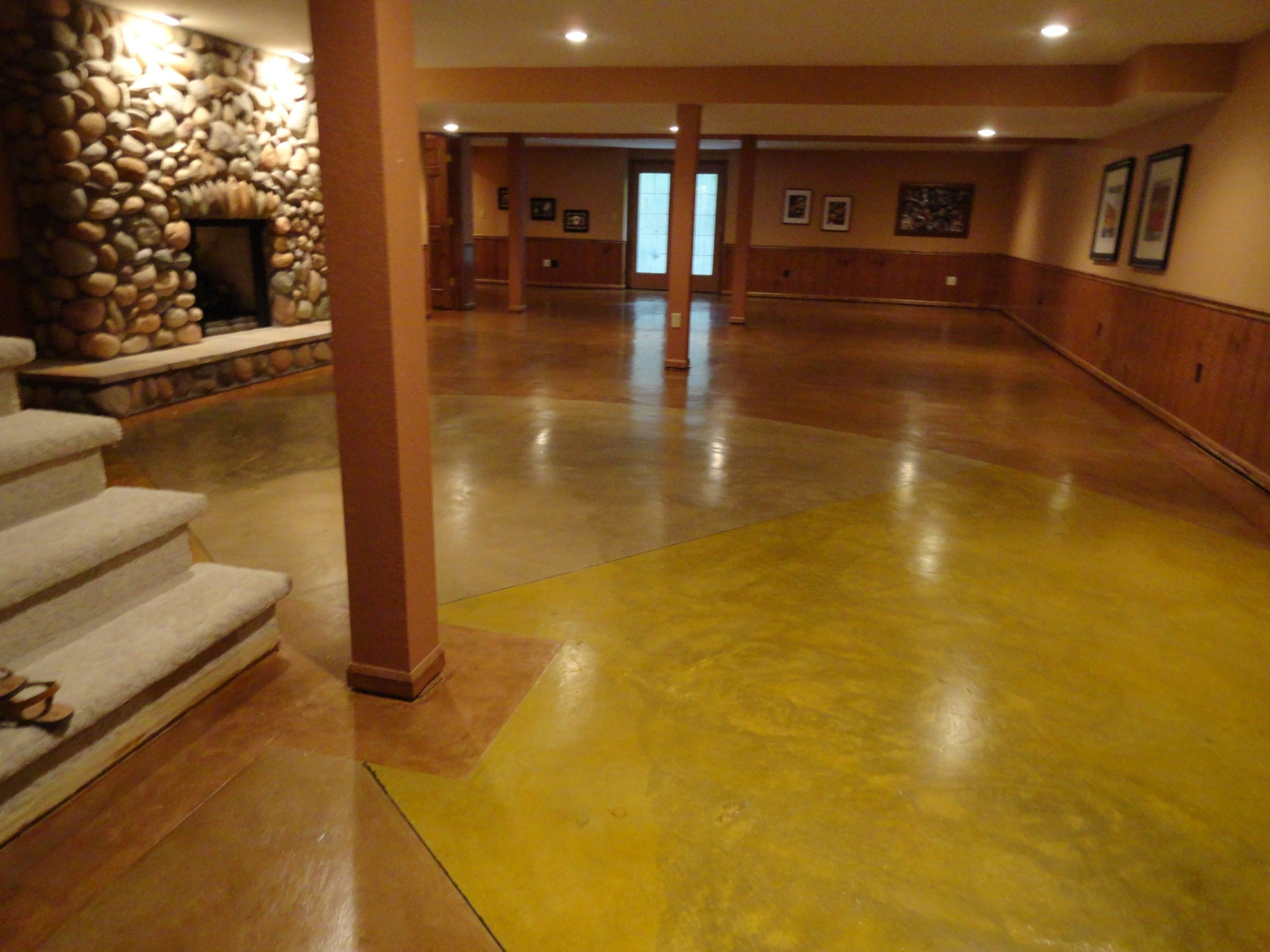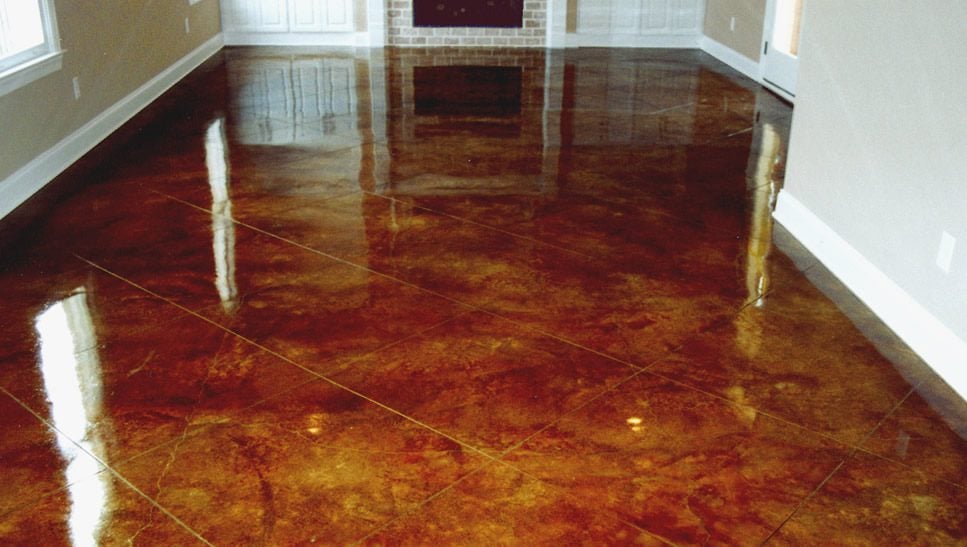Proven strategies for installing austin stained concrete floors
Comprehending the Various Kinds of Stained Concrete for Your Following Project
Stained concrete offers various choices that satisfy different visual and functional demands. Each kind provides unique features that affect the last look and durability of the surface. Recognizing these distinctions is crucial for anyone preparing a task. From abundant, chain reactions of acid-based stains to the vibrant harmony of solid color stains, the selections can considerably influence the outcome. What variables should one take into consideration when picking the optimal stain for their certain requirements?
Summary of Stained Concrete
Stained concrete acts as a flexible floor covering alternative that can enhance the aesthetic appeal of numerous areas. This technique includes using a tinting representative to the surface of existing concrete, enabling a wide spectrum of design opportunities. Stained concrete is popular in both household and industrial settings, using a sturdy and low-maintenance option that can mimic the look of all-natural materials like stone or floor tile.
The staining process can be carried out utilizing water-based or solvent-based items, each offering distinctive aesthetic effects. The final appearance is influenced by aspects such as the original concrete surface area, the kind of tarnish utilized, and the application technique. Stained concrete not only improves interiors and exteriors however also promotes sustainability by rejuvenating existing concrete frameworks. Because of this, it has gained grip amongst property owners and developers looking for both functionality and style in their flooring selections.
Acid-Based Stains: Attributes and Benefits

Unique Color Variants
Concrete surfaces can change significantly with the application of acid-based stains, which offer an abundant palette of one-of-a-kind color variations. These stains permeate the concrete, reacting chemically to generate lively planet tones that vary from deep browns and reds to soft eco-friendlies and blues. The resulting colors are usually variegated, producing a natural, marble-like look that enhances the concrete's character. Each application returns distinctive results due to variations in the concrete's structure and the discoloration technique utilized, making every task distinct. In addition, acid-based stains can be layered or combined with various other techniques to develop personalized layouts, enabling personal expression. This flexibility makes acid-based stains a preferred selection for both property and commercial applications.
Chain Reaction Described
While many elements contribute to the efficiency of acid-based stains, the underlying chemical responses play an important duty in their special attributes and advantages. These stains largely contain water, acid, and metal salts. When put on concrete, the acid reacts with the calcium hydroxide in the concrete, producing a chemical makeover that results in permanent color adjustments. The metallic salts pass through the surface and bond with the concrete, allowing for a wide variety of colors and tones. This response not only boosts aesthetic appeal yet likewise offers durability, making the shade resistant to fading and wear. In addition, acid-based stains can develop a variegated surface that resembles all-natural stone, further improving their appeal for attractive concrete applications.
Surface Area Preparation Relevance
Accomplishing ideal results with acid-based stains pivots on thorough surface prep work. This necessary step assurances that the concrete surface is clean, without pollutants, and correctly profiled for ideal discolor absorption. Any kind of existing sealers, dirt, or oils can prevent the chemical reaction that produces the preferred shade and finish, bring about irregular or uneven outcomes.
Before using the discolor, the concrete must be mechanically cleaned up or stress cleaned, complied with by a comprehensive inspection for splits or imperfections that may need repair. Furthermore, confirming the surface area is properly dried out will improve stain adherence. By focusing on these preparatory measures, the durability and vibrancy of acid-based stains can be considerably boosted, leading to a much more visually pleasing and durable surface.
Water-Based Stains: Functions and Advantages

Water-based stains penetrate the concrete, using a much more translucent finish that highlights the natural texture and variants of the surface under. They are offered in a vast array of shades, enabling for innovative versatility in design. Furthermore, water-based stains are easier to clean up, needing only water and soap, which simplifies the application process.
Their quick drying time improves effectiveness, making them a practical selection for both DIY fanatics and professionals. In general, water-based stains give an enticing combination of visual versatility and user-friendly buildings, making them a prominent alternative for concrete enhancement projects.
Strong Color Stains: Dynamic Options for a Vibrant Appearance
Solid color stains use an efficient solution for those looking for to create a strong and vibrant aesthetic on concrete surface areas. These stains provide an uniform coloration that can drastically improve the visual allure of floors, patios, and driveways. Readily available in a broad spectrum of tones, solid shade stains permit innovative austin stained concrete floors expression, accommodating various layout preferences.
One of the essential advantages of solid shade stains is their capacity to conceal blemishes, giving a fresh and sleek seek to aging concrete - Stained Concrete Floors Austin Texas. Furthermore, their formulation usually consists of UV-resistant buildings, making sure long life and shade retention even in rough climate condition
Application is simple, needing marginal prep work of the concrete surface area. Once applied, solid color stains can be secured for added protection and sheen, more raising their visual quality. With their dynamic alternatives, solid shade stains are a superb choice for those going for an impactful and cohesive layout.
Semi-Transparent Stains: Attaining Depth and Dimension
Semi-transparent stains provide an unique approach to boosting concrete surface areas by offering deepness and measurement via various shade choices. Recognizing the application methods is necessary for achieving the preferred result, while appropriate maintenance practices ensure durability. This area will check out these vital aspects to optimize the benefits of semi-transparent staining.
Shade Options Available
A wide array of shade options exists for semi-transparent stains, enabling home owners and developers to boost the natural elegance of concrete surface areas. These stains can be found in a selection of hues, from earthy tones like browns and terracottas to lively shades such as blues and greens. The semi-transparent nature of these stains permits the underlying concrete to show via, producing a special depth and measurement that can match numerous style aesthetic appeals. Furthermore, integrating different colors can produce custom-made shades, making it possible for a customized seek each task. This flexibility makes semi-transparent stains a preferred choice for both exterior and interior applications, as they can harmonize with surrounding components while including visual passion to simple concrete.
Application Techniques Explained
To attain the preferred deepness and dimension with semi-transparent stains, correct application strategies are crucial. Surface preparation is essential; the concrete has to be tidy and totally free of any contaminants. This typically includes power washing and repairing any kind of splits. Next, selecting the best applicator, such as a sprayer, roller, or brush, can influence the last look. Sprayers permit a more also application, while rollers can assist achieve texture. It is very important to use the discolor in slim, also coats, permitting each layer to completely dry prior to adding one more. Adjusting the application strategy, such as varying pressure or using different tools, can produce special impacts. Finally, securing the stained surface area improves the vibrancy of the colors while supplying security.
Maintenance Finest Practices
Regular maintenance is vital for preserving the elegance and honesty of surfaces treated with semi-transparent stains. To keep these surface areas, routine cleaning is crucial. Utilizing a pH-neutral cleaner and a soft-bristle mop will certainly aid remove dust and debris without harming the stain. It is a good idea to prevent extreme chemicals, as they can break down the tarnish's appearance. Additionally, periodic resealing each to 3 years can secure against wear and fading. This process entails cleaning up the surface completely and applying a compatible sealer created for stained concrete. Homeowners should also check for any indicators of staining or damage and address these concerns immediately to guarantee resilient vibrancy and durability. Following these best methods will certainly improve the overall life-span of semi-transparent stained surface areas.
Impacts and Strategies: Tailoring Your Stained Concrete
Personalizing stained concrete entails a range of techniques that improve both aesthetic appeals and functionality. Amongst these methods, layering various stain colors can produce deepness and intricacy, allowing for one-of-a-kind aesthetic impacts. Techniques such as acid discoloration offer a variegated look, while water-based stains use a more consistent look.
Furthermore, including ornamental patterns, such as stenciling or inscription, can better individualize the surface, including detailed styles that accommodate specific tastes. Texturing the concrete, whether via marking or broom coatings, introduces tactile aspects that not only enhance grasp however also boost visual interest.
Furthermore, using sealants can amplify the color vibrancy and give security against wear. Customization methods expand beyond simple shade; they can transform a standard concrete slab into a magnificent centerpiece, making it appropriate for both property and commercial rooms. Through careful selection of results and techniques, stained concrete can achieve a truly customized look.
Upkeep and Durability of Stained Surfaces
Stained concrete surface areas are known for their longevity and visual allure, keeping their integrity is necessary for guaranteeing longevity. Routine cleaning is important; sweeping and wiping with a pH-neutral cleaner assists avoid dust accumulation and discoloration. Additionally, applying a sealant every couple of years can safeguard the surface area from wetness, chemicals, and UV damage, thus improving its life-span.
It is likewise crucial to attend to any kind of cracks or chips promptly. Little repair work can minimize further deterioration, protecting the aesthetic and structural quality of the surface area. For outside stained concrete, seasonal upkeep, such as eliminating snow and ice, is essential to avoid surface damages from freeze-thaw cycles.
Frequently Asked Questions
Can I Discolor Existing Concrete Surfaces or Just New Ones?
The question of whether existing concrete surface areas can be stained develops often. It is certainly possible to tarnish both brand-new and old concrete, supplied the surface is adequately prepared and complimentary of impurities for excellent bond.
For how long Does the Staining Process Generally Take?
The discoloration process commonly takes one to three days, depending upon aspects such as surface prep work, kind of discolor, and climate conditions. Stained Concrete Floors Austin. Healing time might prolong beyond preliminary application, influencing the total period substantially
Is Stained Concrete Safe for Outdoor Usage?
Stained concrete is normally risk-free for outside usage, offered it is properly sealed. This sealing secures against wetness and UV damage, making certain resilience and safety and security, while additionally improving the visual appeal of exterior spaces.
Can I Use Several Spot Layers for Different Effects?
Using numerous discolor layers can accomplish different impacts on stained concrete. It is necessary to assure compatibility in between stains and enable proper drying out time between applications to prevent unintended reactions or staining.
Are There Any Type Of Color Limitations for Stained Concrete?
Color constraints for stained concrete primarily rely on the sort of stain made use of, with water-based stains supplying a broader palette compared to acid-based stains. Stained Concrete Austin. Achieving vivid colors might call for mindful selection and application methods.